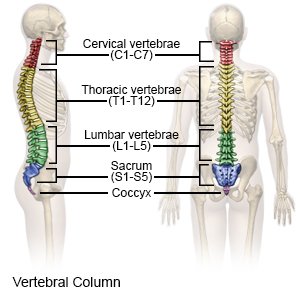Coccyx Injury
Medically reviewed by Drugs.com. Last updated on Aug 4, 2025.
A coccyx (tailbone) injury may include a fracture or dislocation.
 |
DISCHARGE INSTRUCTIONS:
Call your local emergency number (911 in the US) if:
- You cannot move your legs.
- Your legs suddenly go numb.
Return to the emergency department if:
- You have severe pain.
Call your doctor if:
- You have trouble urinating or having a bowel movement.
- Your pain or swelling gets worse or do not go away with treatment.
- You have a fever.
- You have questions or concerns about your condition or care.
Medicines:
You may need any of the following:
- NSAIDs , such as ibuprofen, help decrease swelling, pain, and fever. NSAIDs can cause stomach bleeding or kidney problems in certain people. If you take blood thinner medicine, always ask your healthcare provider if NSAIDs are safe for you. Always read the medicine label and follow directions.
- Prescription pain medicine may be given. Ask your healthcare provider how to take this medicine safely. Some prescription pain medicines contain acetaminophen. Do not take other medicines that contain acetaminophen without talking to your healthcare provider. Too much acetaminophen may cause liver damage. Prescription pain medicine may cause constipation. Ask your healthcare provider how to prevent or treat constipation.
- A bowel movement softener makes it easier and less painful for you to have a bowel movement.
- Take your medicine as directed. Contact your healthcare provider if you think your medicine is not helping or if you have side effects. Tell your provider if you are allergic to any medicine. Keep a list of the medicines, vitamins, and herbs you take. Include the amounts, and when and why you take them. Bring the list or the pill bottles to follow-up visits. Carry your medicine list with you in case of an emergency.
Self-care:
- Use a donut-shaped cushion to decrease pain and support your coccyx when you sit.
- Apply ice to help decrease swelling and pain. Use an ice pack, or put crushed ice in a plastic bag. Cover it with a towel and place it on your coccyx for 15 to 20 minutes every hour or as directed.
- Sleep on a firm mattress. Place a pillow under your knees if you sleep on your back. Or, sleep on your side with a pillow between your knees. This will decrease pain and tension in your coccyx and back.
Follow up with your doctor as directed:
Write down your questions so you remember to ask them during your visits.
© Copyright Merative 2025 Information is for End User's use only and may not be sold, redistributed or otherwise used for commercial purposes.
The above information is an educational aid only. It is not intended as medical advice for individual conditions or treatments. Talk to your doctor, nurse or pharmacist before following any medical regimen to see if it is safe and effective for you.
Learn more about Coccyx Injury
Care guides
Further information
Always consult your healthcare provider to ensure the information displayed on this page applies to your personal circumstances.
